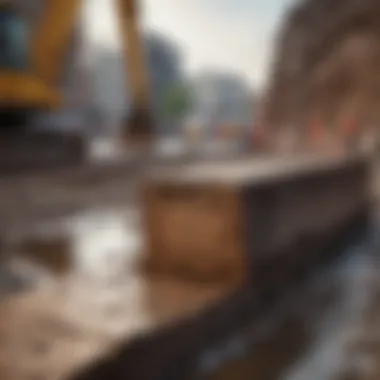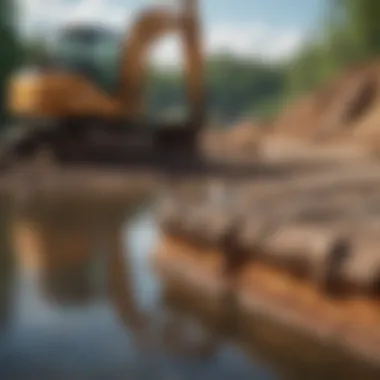Unveiling the Crucial Role of Sheet Piling in Shoring Techniques


Overview of the Topic
Sheet piling is a vital component in shoring techniques, offering essential support and stability to excavation sites. This section will provide insights into the integral role that sheet piling plays in various construction scenarios. Understanding the significance and applications of sheet piling is crucial for ensuring the safety and efficiency of excavation projects.
Current State and Challenges
In examining the current state of sheet piling in shoring techniques, it becomes evident that there are challenges and threats that face this essential construction practice. Issues such as material selection, installation techniques, and environmental impact need to be carefully considered to overcome these challenges and ensure the sustainable use of sheet piling.
Sustainable Solutions
Exploring sustainable practices and solutions for sheet piling in shoring techniques is imperative for mitigating environmental concerns and enhancing the longevity of construction projects. By adopting innovative technologies, such as recyclable materials and efficient installation methods, the construction industry can achieve greater sustainability in sheet piling practices.
Impact and Importance
The impact of sheet piling on construction sites, ecosystems, and communities cannot be overlooked. This section will delve into the crucial role that sheet piling plays in ensuring the stability of excavation sites while emphasizing the importance of conservation efforts and sustainable resource use. By prioritizing the responsible use of sheet piling, construction professionals can contribute to a more sustainable future for generations to come.
Introduction to Sheet Piling
Sheet piling serves as a pivotal technique in shoring methods, offering essential support and stability to excavation sites. Its significance lies in providing structural reinforcement and preventing soil erosion. By understanding the concept of sheet piling, one can appreciate its vital role in various construction scenarios. This section sheds light on the key elements and considerations related to the introduction of sheet piling, elucidating its importance in ensuring the stability and safety of construction projects.
Understanding the Concept of Sheet Piling
Definition and Purpose of Sheet Piling
Sheet piling, characterized by its vertically interlocking sections, is designed to create a barrier against soil and water pressures while excavating or constructing structures. Its primary purpose is to provide temporary or permanent support, facilitating safe working conditions in tricky terrains. The key feature of sheet piling is its versatility, enabling it to adapt to varying soil compositions. Despite its efficiency, sheet piling also possesses limitations, such as potential corrosion in certain environments. However, its numerous advantages in offering quick installation and cost-effectiveness make it a preferred choice in shoring techniques.


Historical Evolution of Sheet Piling Techniques
The evolution of sheet piling techniques traces back centuries, with early civilizations using rudimentary forms of piling for foundation support. Over time, innovations in materials and construction methods have revolutionized sheet piling, enhancing its durability and load-bearing capacity. The historical progression highlights the continuous refinement of sheet piling designs to optimize structural strength and stability. While advancements have addressed earlier challenges, newer techniques still face issues like environmental impact and sustainability. Despite these drawbacks, historical knowledge informs present-day practices, guiding engineers in deploying efficient and durable sheet piling solutions.
Types of Sheet Piling Materials
Steel Sheet Piles
Steel sheet piles, known for their robustness and longevity, are prized for withstanding high vertical loads and harsh environmental conditions. Their key characteristic lies in their flexibility, allowing for cohesive interlocking and seamless installation. However, the high cost and potential impact on the environment due to steel production are notable considerations. Despite these drawbacks, the unparalleled strength of steel sheet piles makes them indispensable in bolstering structures against external pressures.
Vinyl Sheet Piles
Vinyl sheet piles offer a sustainable and environmentally friendly alternative to traditional materials, boasting excellent corrosion resistance and ease of handling. Their key characteristic includes lightweight properties, enabling simplified transportation and installation. Although vinyl sheet piles may have limitations concerning load-bearing capacities in certain applications, their non-toxic nature and recyclability position them as an eco-conscious choice in construction projects.
Concrete Sheet Piles
Concrete sheet piles are renowned for their durability, providing robust support against soil pressures and water seepage. Their key characteristic lies in the high density and stability they offer, ensuring long-term structural integrity. Despite the challenges related to transportation and installation due to their weight, concrete sheet piles excel in scenarios requiring substantial load-bearing capabilities and can be reinforced for enhanced performance. Choosing the appropriate material for sheet piling involves weighing these unique features and understanding how they align with the project's requirements for stability and longevity.
Importdrnce of Sheet Piling in Shoriobg
Sheet piling plays a cruciol role in shoring techniques by providing vitol support ond stobility to excavation sites. It is o technico rigorously engineered structure commonly used in construction to prevent soil displlocement ond support buildings. Besides enhoncing structurdl stability, sheet piling fundmentolly contributes to protect buildings oc sincured cround from distress. The rotionole of sheet piling in shoring is cruciodl for ensuring the proper function of embankments ond reinforcing soft soil needed in constructions of bridge abutments or btreet foundations. The elements of compacting soilnd used to fill in gaps betweeb sheets effectively regain the grams of the cyett-earth pressure balance. Such techniques of tile rumdpatingcomeith viable benefits, effectively contributing to the cebopionlyncept of building & construction within the logistics and frameworks in various projects. Moreover, great consideration should also be applied to the environmental impactldromave buildings spaces where these engineerirpecific techniques are present, integrating sustainable approach to minimize disrupting owalkingareasses.
Applications of Sheet Piling in Various Industries
The significance of applications of sheet piling in various industries cannot be overstated in the realm of construction. These techniques play a pivotal role in ensuring stability and structural integrity in a wide array of construction projects. The utilization of sheet piling in the construction sector offers numerous benefits such as foundation stabilization and trench shoring. Whether it is providing support to building foundations or reinforcing trenches, the versatility of sheet piling makes it an indispensable tool across different industries.


Construction Sector
Foundation Stabilization
Foundation stabilization stands out as a critical aspect in construction projects, ensuring the strength and durability of the structures built upon it. By utilizing sheet piling for foundation stabilization, construction engineers can mitigate the risks associated with soil movement and settling. The key characteristic of foundation stabilization lies in its ability to distribute loads evenly, thereby preventing potential structural damage. This method is a popular choice in construction due to its effectiveness in enhancing the longevity of buildings and infrastructure. Despite its advantages, foundation stabilization may have limitations based on soil properties and environmental factors, necessitating a thorough understanding of the site conditions.
Trench Shoring
Trench shoring is another vital application of sheet piling in the construction sector, primarily used to provide safety and support in excavated areas. The key advantage of trench shoring lies in its ability to prevent cave-ins and maintain soil stability during construction activities. This method is crucial for creating safe working conditions for construction workers while minimizing the risks of accidents or structural failures. However, trench shoring may have drawbacks related to the installation complexity and material limitations, requiring careful planning and execution to achieve optimal results.
Marine and Coastal Engineering
Dock Construction
Dock construction represents a key area where sheet piling plays a significant role in providing stability and resilience to maritime structures. The unique feature of dock construction using sheet piling lies in its effectiveness in resisting water pressure and supporting marine vessels. This method is preferred in coastal areas for its durability and cost-efficiency in building robust dock facilities. Despite its advantages, dock construction through sheet piling may pose challenges concerning maintenance requirements and environmental impacts, necessitating sustainable practices to ensure long-term functionality.
Seawall Maintenance
Seawall maintenance involves the upkeep and reinforcement of existing coastal barriers to withstand wave forces and protect coastal areas from erosion. The key characteristic of seawall maintenance utilizing sheet piling lies in its ability to enhance coastal resilience and biodiversity conservation. This method is favored for its ecological benefits and effectiveness in mitigating coastal erosion. However, seawall maintenance through sheet piling may face limitations related to resource allocation and environmental regulations, requiring a balanced approach to sustainable coastal management.
Environmental Impact of Sheet Piling Practices
The section dedicated to the Environmental Impact of Sheet Piling Practices is of paramount importance in this discourse. It sheds light on the intricate balance between construction necessities and ecological preservation, emphasizing the need for sustainable practices in the industry. By delving into the repercussions of sheet piling on the environment, we gain a deeper understanding of how technology and nature can coexist harmoniously.
Mitigating Ecological Effects


Erosion Control Measures
Erosion Control Measures serve as a pivotal aspect within the realm of sheet piling practices, warranting attention due to their significant contribution to preserving landscapes. These measures play a crucial role in minimizing soil erosion, safeguarding against the detrimental effects of excavation activities on natural terrains. One key characteristic of Erosion Control Measures is their ability to enhance soil stability, reducing the risk of sediment runoff and land degradation. Their popularity stems from the positive impact they have on land conservation efforts, making them a preferred choice in environmentally conscious construction projects. The unique feature of Erosion Control Measures lies in their adaptive nature, offering versatility in mitigating erosion challenges across various topographies. While advantageous in preventing environmental degradation, challenges may arise in the implementation of these measures, necessitating constant monitoring and adaptation to site-specific conditions.
Protected Marine Habitats
The inclusion of Protected Marine Habitats within the discussion on sheet piling's environmental impact underscores the significance of marine ecosystem conservation. By safeguarding these habitats, sheet piling projects can minimize disturbances to aquatic life and biodiversity, promoting sustainable coexistence between construction activities and marine environments. A key characteristic of Protected Marine Habitats is their role in preserving endangered species and maintaining ecological balance within coastal regions. Their preference in this context arises from their ability to ensure minimal disruption to sensitive marine ecosystems, aligning with environmentally responsible construction practices. The unique feature of Protected Marine Habitats lies in their long-term positive effects on marine biodiversity and habitat integrity. While advantageous in promoting marine conservation, challenges may emerge in balancing construction needs with habitat preservation, necessitating strategic planning and adherence to regulatory guidelines.
Sustainable Construction Approaches
The Sustainable Construction Approaches section accentuates the importance of implementing environmentally friendly practices within the realm of sheet piling techniques. By exploring the use of recyclable piling materials and low-impact installation techniques, we delve into innovative solutions that prioritize sustainability without compromising structural integrity.
Recyclable Piling Materials
Discussion about Recyclable Piling Materials emphasizes the need for minimizing resource depletion and waste generation in construction projects. By opting for recyclable materials, construction sites can reduce their environmental footprint and promote circular economy principles. A key characteristic of Recyclable Piling Materials is their ability to be reused or repurposed after the project's completion, minimizing material wastage and conserving natural resources. Their popularity in sustainable construction practices stems from their contribution to reducing carbon emissions and promoting material sustainability. The unique feature of Recyclable Piling Materials lies in their potential for multiple lifecycles, offering cost-effective and environmentally sound alternatives to traditional construction materials. While advantageous in promoting resource efficiency, challenges may surface in sourcing reliable recycled materials and ensuring their structural suitability for specific project requirements.
Low-Impact Installation Techniques
Exploration of Low-Impact Installation Techniques highlights the significance of minimizing construction-related disturbances to surrounding environments. By adopting techniques that reduce noise pollution, vibration, and site disruption, construction projects can mitigate their overall environmental impact. A key characteristic of Low-Impact Installation Techniques is their ability to ensure precision and efficiency while minimizing ecological footprint, aligning with sustainable construction practices. Their favorable reception in the industry arises from their capacity to limit soil compaction and ecosystem disturbance during installation processes. The unique feature of Low-Impact Installation Techniques lies in their integration of technology and skilled labor, optimizing construction operations for minimal environmental detriment. While advantageous in promoting site sustainability, challenges may arise in initial implementation costs and the need for specialized training to execute these techniques effectively.
Innovations in Sheet Piling Technology
In the realm of engineering and construction, embracing Innovations in Sheet Piling Technology is paramount to ensure the longevity and efficacy of shoring techniques. These advancements play a pivotal role in modern construction practices, offering enhanced durability, efficiency, and cost-effectiveness. By delving into new technologies and techniques, construction projects can achieve heightened levels of structural integrity and environmental sustainability. The development of innovative sheet piling solutions not only elevates the efficiency of shoring methods but also minimizes the environmental footprint of construction processes, aligning with contemporary sustainability goals. By analyzing the benefits, considerations, and implications of Innovations in Sheet Piling Technology, this article provides a comprehensive understanding of how technological advancements shape the landscape of shoring practices.
Advancements in Sheet Piling Designs
Interlocking Systems
When exploring Interlocking Systems within the domain of sheet piling technology, one encounters a fundamental aspect that revolutionizes the traditional approach to structural stability. The key characteristic of Interlocking Systems lies in their ability to provide seamless and secure connections between sheet piles, enhancing structural resilience and load-bearing capacity. This innovative design feature ensures enhanced performance in retaining walls, flood protection barriers, and excavation support structures. The unique feature of Interlocking Systems lies in their modular nature, allowing for quick and efficient installation while maintaining structural integrity. Despite their many advantages, Interlocking Systems may pose challenges in terms of specialized equipment requirements and initial investment costs. However, the long-term benefits of enhanced durability and reliability make Interlocking Systems a favored choice in contemporary sheet piling applications.
Corrosion-Resistant Coatings
Corrosion-Resistant Coatings serve as a critical element in preserving the longevity and functionality of sheet piling structures. The primary characteristic of these coatings is their ability to protect sheet piles from corrosion caused by environmental factors such as moisture and chemical exposure. By forming a protective barrier on the surface of sheet piles, Corrosion-Resistant Coatings enhance their lifespan and structural stability, thereby reducing maintenance costs and extending service life. The unique feature of Corrosion-Resistant Coatings lies in their versatility, as they can be customized to suit specific environmental conditions and project requirements. While these coatings offer unparalleled protection, considerations must be made regarding application methods, compatibility with different materials, and long-term performance under varying conditions. Despite these considerations, the advantages of increased durability and corrosion resistance make Corrosion-Resistant Coatings indispensable in the realm of sheet piling technology.



